Athens
The ancient city of Athens is a treasure trove for history-enthused travellers like myself.
With ancient sites spread throughout the boundaries of the city, a trip to he Greek capital is a must for those with one eye on the past.
The question is, even with its almost incomparable history, is Athens worth visiting for those who don’t want to just go on a magical journey back in time?
The simple answer is yes! Not only is it the largest city in Greece, modern Athens is no longer just a starting point for travellers to visit the Greek islands. The city is a destination in its own right, where ancient ruins ooze Greek history and where great bars and restaurants appeal to today’s sophisticated adventure-seekers.
That being said – and like the Italian capital city of Rome – it’s nigh on impossible to walk the streets of this city without coming face-to-face with something highlighting its extraordinary past.
And with many of its key sites inland, it’s easy to forget that Athens is a coastal city in the Mediterranean and boasts a stunning shoreline with many glorious, nearby, beaches
The city of Athens has a population of around 640,000 as of 2021) and a land area of 38.96km2 (15.04 square miles). However, the Athens Metropolitan Area or Greater Athens as it’s sometimes known, extends beyond its administrative municipal city limits, with a population of 3.7 million (in 2021) over an area of 412km2 (159 square miles).
Located in the south of Greece – in a region known as Attica – Athens is one of the world’s oldest cities. The area has been continuously inhabited for at least 5,000 years with its recorded history spanning over 3,400 years.
With signs of its earliest human presence beginning somewhere between the 11th and 7th millennia BC, Athens is widely being referred to as the cradle of western civilization and the birthplace of democracy.
The heritage of the city’s ancient past is evident and represented by monuments; the most famous of all being the Parthenon which is considered to be a key landmark of early western civilisation. In addition to this, Athens is home to two UNESCO World Heritage Sites, the Acropolis of Athens – which houses the Parthenon (more on that area later in the blog) and the medieval Daphni Monastery.
For me, Athens was always very much on my to-do list but, like so many locations, kept being pushed back and back to the point where it just was never happening. It took a somewhat concerted effort on my part to bring the Greek capital back to the forefront of my attention; something which I’m extremely glad I did.
While the historic sites were the main draw for me, there were other aspects of the city’s culture I wanted to experience, including it’s cuisine and it’s city life.
So what should a first time visitor to Athens know before heading to the Greek capital?
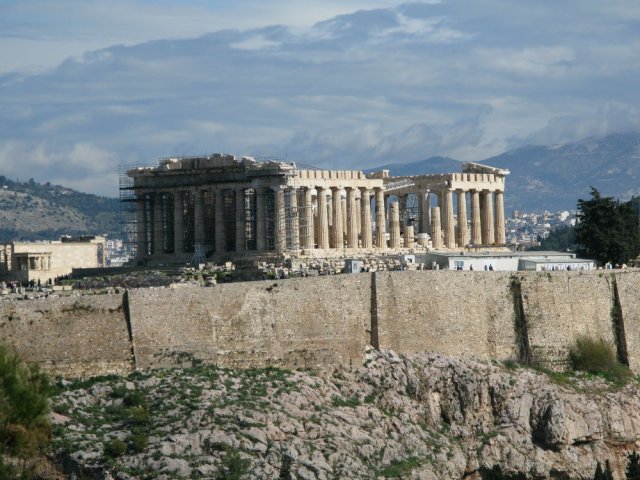
The first thing I’ll point out is the weather.
Athens has a hot-summer Mediterranean climate and is reported to be the hottest city in mainland Europe! The dominant feature of Athens’ climate is alternation between prolonged hot and dry summers and mild, wetter winters with moderate rainfall.
When I visited Athens, it was early in the year (around February / March time) so average daily highs were around 14°C to 17°C with around a couple of inches of rainfall – on average – daily.
However, if you visit the city in the summer months, you can expect temperatures to soar to the nearer 35°C on average (a record high in the city was recorded at 44.8°C on one extreme June day), along with very little rainfall. If you do choose to visit then, take plenty of sun lotion, as well as suitable hot weather clothes.
If – like me – the thought of those temperatures is a little too intense for you, then the late winter months are a welcome alternative. With moderate temperatures – that feel a lot warmer when come from a colder climate like the UK – you can be pretty comfortable wearing jeans, t-shirts and a light jacket.
In addition however, do take some wet-weather clothes and umbrellas as downpours are a possibility. I remember walking from my accommodation towards towards the Acropolis and getting absolutely drenched when the heavens opened for a short 10 minute rain shower!
The next thing to think about is the currency. Like a lot of mainland Europe the Euro is used in Greece. At the time of writing, £1 sterling would get you around €1.15.
Financially, a trip to Athens won’t have a massive negative effect on your pockets. In a survey conducted by the Post Office towards the end of 2022, Athens was ranked the cheapest location for a city break on the continent, ahead of traditional budget-friendly eastern European cities like Krakow in Poland and Riga in Latvia.
It’s great news for those travelling on a tight budget and means you are able to squeeze in a lot of activities without having to break the bank.
The next thing to think about is the time zone differences. If you are travelling from England, then there is a two-hour time zone difference to take into consideration for Greece. This means you’ll lose two hours on your travel to the country but gain them back again when you return.

Another thing to consider is the plug points in Greece to ensure that all your devices have power.
For Greece there are two associated plug types C and F. Plug type C is the plug which has two round pins and plug type F is the plug which has two round pins with two earth clips on the side. Greece operates on a 230V supply voltage and 50Hz.
A final thing to consider is the difference in the language.
Although the official language in Greece is, of course, Greek, English is widely spoken, meaning you shouldn’t experience any problems when visiting the city. English is very widely spoken in Greece, especially in the most touristy parts of the city.
That said, it’s always advisable to carry around a small list of useful expressions just in case you come across non-English speakers. Just knowing the likes of hello and goodbye (yásas), please (parakaló) and thank you (efjaristó) can be a massive help.
Aside from the spoken form of Greek, you’ll also encounter a different alphabet when observing it in its written form (should you be travelling from the UK or other location where the Greek language is not spoken).
The Greek alphabet has been used to write the Greek language since the late 9th or early 8th century BC and is made up of 24 letters. It is deemed the ancestor of is the ancestor of the Latin and Cyrillic scripts that many will be more familiar with.
It does mean however – that for a non-speaker – trying to decipher information in this language is very difficult as the letters and their sounds are not ones we are familiar with.
However, as previously mentioned, Athens is a progressive city and many places acknowledge most travellers will need to see and hear information in foreign languages to their own, so getting by is a fairly straight-forward affair.
With that in mind, the final thing I’d suggest you do before setting off is research (hopefully this blog can help with that to a degree) what you want to see and do in Athens to ensure you make the most of your time in the cradle of western civilisation.
Getting there
Flying to Athens is the most direct and logical way to get to the Greek capital.
There are other methods including by cruise liner, but for me, a three and a half hour flight from London made the most sense for a short city break.
As a major hub in Greece, Athens welcomes flights from many airlines from across the world to its main airport; Athens International.
From the UK there are a number of options for flights including the budget airlines like EasyJet (which depart from Bristol, London Gatwick and Manchester) and Ryanair (who travel from London Stansted) as well as the Greek airline, Aegean Airlines (who depart from London Heathrow, Manchester, Birmingham, Edinburgh and – seasonally – London Gatwick).
However, for my trip I used British Airways; travelling out of London Heathrow. There were a couple of reasons for this. The first being that the times of the flights suited me best (I was able to depart at 7:55am on a Friday morning and come back by 4:30pm the following Monday), and the second being the combined good value of the cost when I was spending my Avios airmiles points.
At the time of my trip, the flights cost me £105.70 (before Avios points savings) per person. However, this was pre-Covid-19 and prices have increased since then. At the time of writing, for a return ticket in February, you can expect to pay a minimum of £180 per person!
The flight itself was fine, if a little underwhelming. I’ll admit I was perhaps expecting a little more in terms of service when I booked the tickets as my previous experience with British Airways had been pretty good.
However, on this occasion, the flight offered little more than a standard budget airline one would and there really were no extra perks for flying with British Airways over that of EasyJet or Ryanair. You live and learn!
When you arrive in Athens and get your first feel of Greek air, you notice the airport is set across two terminals; the Main Terminal and the Satellite Terminal.
In the Main Terminal – which is housed in a three-story building – are all 144 check-in desks as well as Hall A (international flights to Non-European countries and Non-Schengen countries and Hall B (domestic and intra-Schengen flights).
The second terminal called The Satellite Terminal consists of two levels, one for arrivals and one for departures, and is used by around 10 airlines including Ryanair, Easyjet, Vueling, and Norwegian.
Opened in 2001, the Athens International was designed to be extended in a modular approach over the ensuing years in order to accommodate increases in air travel and includes a very useful metro link that takes you to the heart of Athens directly (more on that later).
These extensions are planned in a six-phase framework. The first phase allowed the airport to accommodate 26 million passengers per year (this is a pre-Covid-19 figure). When the airport originally opened, the first phase called for a capacity of only 16 million passengers per year.
The sixth and final expansion phase will allow the airport to accommodate an annual traffic of 50 million passengers, with the current layout leaving enough space for five more terminals to be added!
The airport is located around 33km (around 20.5 miles) southeast of Athens. It is easily accessible via the Athens ring road (Attiki Odos) or via the aforementioned metro. The drive from downtown Athens takes 30-45 minutes, depending on traffic.
Once travellers make their way through the maze of airport security and out of the arrivals gates, they are free to start exploring the Greece.


Where to stay
As with all major cities, there are a plethora of hotels spread throughout Athens that can cover a variety of needs and budgets.
Once again, though (and this won’t be news to anyone who has read any of my other blogs on this site), I opted for the use of a trusty AirBnB.
Located in a quiet part of town, this cosy loft apartment is a mere 15 minute walk away from the Acropolis of Athens.
In the nearby streets there are a few local stores to buy some in-house essentials – breakfast items for example. The roads are also often lined with beautiful orange trees that were full to burst with their fruits as I walked past. You can just pick one off a tree and eat it (if it’s ripe enough) or simply enjoy the wonderful citrus fruit smell that joins you as you stroll down the road.
Upon arrival outside the apartment – located on a road called Taichman – I met with my host; a very friendly guy called Dpa. He welcomed me to Greece and took me inside to check out the place and to give a quick guided tour.
Throughout the stay Dpa remained in contact with me via the AirBnB app as was always responsive and helpful with tips and advice.
The apartment itself is fairly compacted. Located on the upper floor of a small building, there is a bedroom which comfortably houses two people, as well as a kitchen area that leads into a small bathroom.
The main feature of this place however, is its outside space.
From both the bedroom and the kitchen you can venture outside to a large balcony area that extends around two sides of the building and is equip with a selection of garden furniture.
Despite travelling in February, the weather in Greece still allows for this area to be enjoyed during a stay and, I imagine, this would be even better in the hot summer months.
Considering it is well located, the price of this apartment was extremely reasonable also. For three nights, I paid £126.45 in total (making it just £42.15 per night)! I have checked at the time of writing this blog and, while prices have increased slightly, the cost of a trip in February now is only £137 in total (making it just £45.66 per night).
For this bargain price, you get a great private location and the ability to spend the money you’ve saved on accommodation on activities to enjoy.

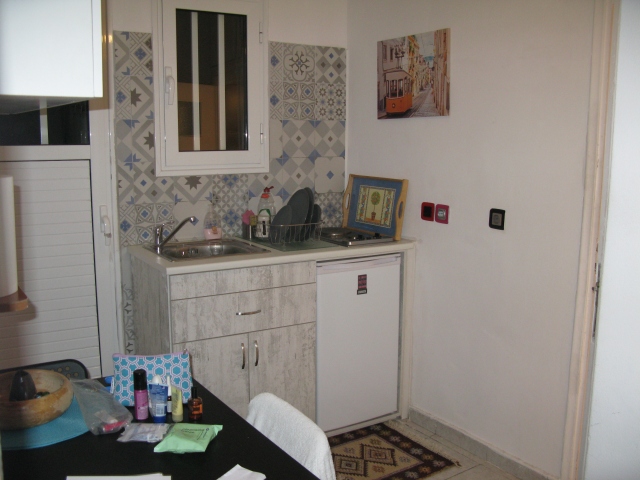


Getting around
For me, the best way to explore a new city is to do it independently and on foot. This works well for the centre of Athens as many of the areas are pedestrianised with cobbled streets which makes walking a great options (although make sure you wear some comfy shoes with good cushioning)
It also helps if you are willing and able to walk as with the city being the heartbeat of ancient Greece, there are a number of areas that more modern options (like trams and metro lines) just cannot access.
To give a basic idea, most ancient sites can be reached from the Acropolis of Athens (as a focal starting point) within about 20 to 30 minutes of walking.
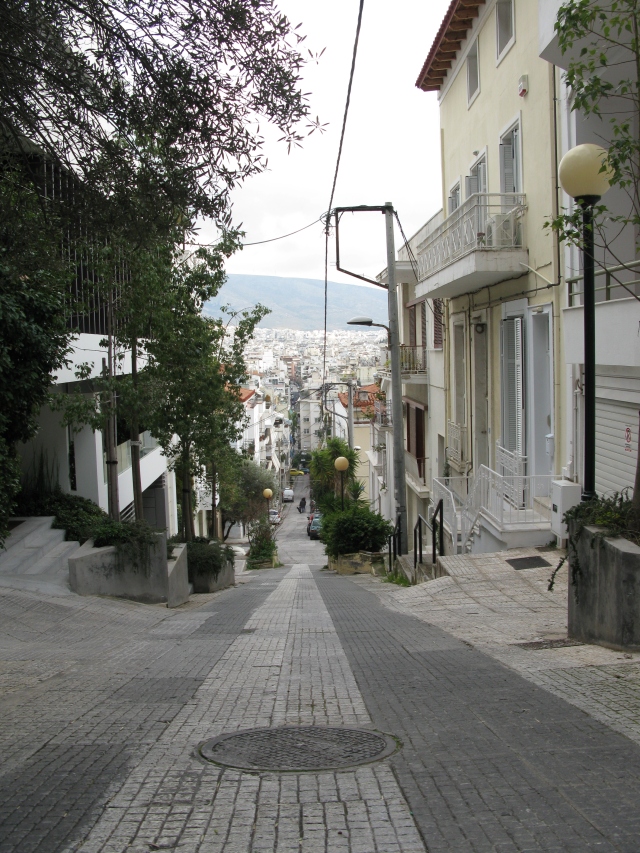
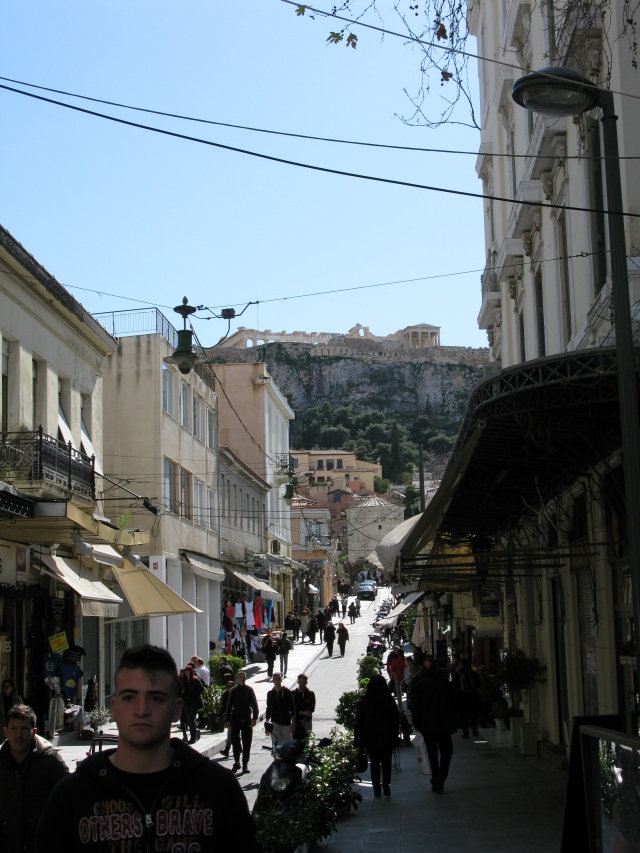
However, it is inevitable that during a stay in the city you’ll end up using the Athens Metro a fair bit too.
The metro – which initially opened over 150 years ago in 1869 – is split into three lines with a fourth suburban railway also accessing some of the same stations.
What you’ll notice straight away is that there are not many of the 66 station on the network that cross over multiple lines (in fact there are only 10 that do and a number of these are on the route to the airport).
That said, the service is good and helps get you from A to B quickly and efficiently.
The metro runs daily from 5am to midnight. Lines 2 and 3 operate until 2am on Fridays and Saturdays. At peak hours, trains run every five to six minutes.
The network of stations also gets you close to some of the main sites and stations that are likely to be of use are Akropoli to the Acropolis of Athens, the Acropolis Museum and other ancient sites and Evangelismos for Mount Lycabettus.
The first time I used it was to get from the airport to the city centre which a good, cheap method to get into Athens when you arrive.
Metro Line 3 connects the airport to the city centre (Syntagma Square). The journey time is approximately 40 minutes and trains depart the station every 30 minutes, seven days a week from 6:30am to 11:30pm. One way tickets cost €9 (around £8) for adults, and €4.50 (around £4) for children, teenagers, over 65. A return tickets cost €16 (around £14).
Fares are prepaid, either as short term tickets valid for 90 minutes, 24 hours, three days, five days, or as long term tickets. As of September 2020, there are two types of fare products, the ATH.ENA Ticket and ATH.ENA Card; both of which are validated using a contactless system (by scanning the ticket or card at the electronic validating machines).
As an indication of prices, a single ticket is valid for 90 minutes and costs €1.20 (around £1), a return ticket costs €2.30 (around £2), a daily ticket, which is valid for 24 hours, costs €4.10 (around £3.40) or a five-day ticket costs €8.20 (around £6.80).
It’s also worth noting that these tickets can be used on all means of public transportation in Athens. You can purchase several single tickets in advance, or even a pack of 10+1 tickets, which gives you a small discount.

Top sites
Athens is a rich treasure-trove of fantastic ancient sites to visit. It means that – for those who are undertaking a short trip to the Greek capital – it’s vital that you pick and choose wisely where to spend your time.
But no matter where your interests lie, the first stop on everyone’s agenda is always the Acropolis of Athens & Parthenon.
Located in the heart of the city, you can get to the Acropolis either by walking or by using the metro and getting off at the Acropoli station on the M2 red line. From here, a 10-minute walk will get you to the Acropolis.
The Acropolis of Athens is an ancient citadel located on a rocky outcrop above the city of Athens and contains the remains of several ancient buildings of great architectural and historical significance, the most famous being the Parthenon – former temple that was dedicated to the goddess Athena during the fifth century BC.
Possibly the most famous site within Athens, the Parthenon was built in thanksgiving for the Hellenic victory over Persian invaders during the Greco-Persian Wars. Like most Greek temples, the Parthenon also served as the city treasury.
Today, the ancient site is a shell of its former glory (and more often-than-not covered in scaffolding) but it still remains an awe inspiring sight that is visible from numerous locations in the city thanks to its elevated position.
While you cannot go within its boundaries, you can walk around the majority of the outside and peer through its rows of towering columns and large stony steps.
Entry to the Acropolis gives you access to more than just views of the Parthenon however.
Once inside the ancient citadel’s boundaries, a ticket also includes the likes of the Erechtheion, Temple of Athena Nike, Old Temple of Athena and Sanctuary of Zeus Polieus, as well as the North and South Slopes which includes the Theatre of Dionysus and views into the Odeon of Herodes Atticus.
Considering its popularity, tickets for this famous site are reasonably priced. For trips between 1 April and 31 October, a standard ticket costs €20 (about £17.60) while visits between 1 November and 31 March cost just €10 (around £8.80).
It’s worth remembering how popular this site is though when planning a trip. If you can, buy tickets online before you go in order to avoid the queue, or – as I did – arrive for its opening time (8am) in order to have the sight as empty as possible.


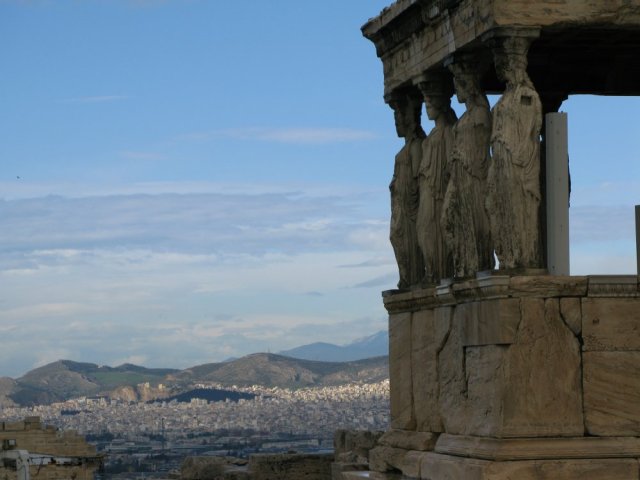
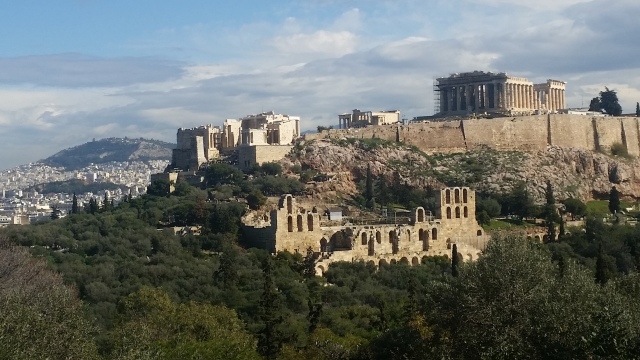

The next place to make a stop after leaving the Acropolis is a short five-minute walk down to Promachou Street, situated on the south-eastern slope of the Acropolis hill.
Here you will find the enchanting and mesmerising Acroplois Museum.
This archaeological institution focuses on the findings from the Acropolis of Athens – initially founded in 2003 and opened fully in 2009 – and houses every artefact found on the rock, and the surrounding slopes, from the Greek Bronze Age to Roman and Byzantine Greece.
The biggest miss from this museum remains the fact that the famous Elgin Marbles – sculptures from the Acropolis bought in the early 19th Century by Thomas Bruce, 7th Earl of Elgin – are still held in England at the British Museum. The museum – and Greece as a whole – still hope that these will one day return to their rightful home, with the museum having a placeholder in situ should that day ever arrive. At the time of writing, however, this still looks to be some way off.
That aside, the museum is a magnificent treasure-trove of intrigue and wonder. Artefacts line its spacious open hallways and exhibition rooms and there is plenty of information and insight to keep all its guests entertained and educated.
As a working site, there remain continuous excavation efforts taking place below the ground-level with the site and process made visible through the ground-level glass floor. From June 2019, this has also opened to the public for visits.
Considering the draw this museum has, during my visit, there was plenty of room to enjoy the exhibitions without feeling like you must rush to get out of others’ way.
The prices for entry are also extremely reasonable with a small difference depending on the season you visit.
For trips between 1 November and 31 March prices are €10 per person (around £8.80), while trips between 1 April and 31 October are priced slightly higher at €15 (around £13.35). Either way, the price represents excellent value for money.
Opening times are always set at 9am so for those who want to be first in, should head down for this time while closing times differ between 5pm at the earliest (Monday to Thursday) through to 10pm at the latest (Friday). At weekends, the closing time is 8pm.
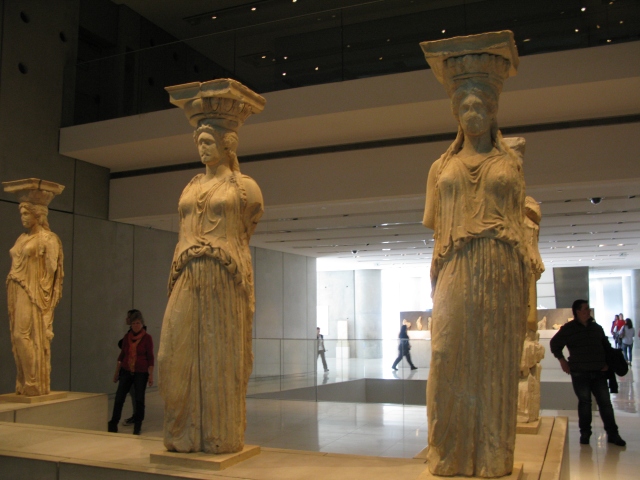


A short walk west from the Acropolis lies Philopappos Hill; affording stunning views of the Acropolis and the greater Athens area.
The origins of Philopappos Hill date back to ancient times when it went by the name Muse Hill. The ancient Athenians assumed that the muses of the gods resided here.
Along with Nymph Hill and Pnyx, Philopappos Hill forms a chain of hills. The popular assemblies of the free citizens of Athens took place here, where they discussed political issues and made important decisions.
The hill – which is free to climb – is home to the two-story, Philopappos’ Monument at its highest point.
The monument is impressive but the main draw for me which made me take the walk up the hill – which stands at a height of 147m – was to get views of Athens from one of the city’s most beautiful vantage points.
As a fair warning, the climb up is steep and could be difficult for those with mobility issues. The climb should take around 10 to 15 minutes, but once at the top, the reward is a breath-taking panorama of the city.
From this vantage-point you can see the Acropolis in the foreground, right across Athens and down to the seaside town of Piraeus. The bonus here is that, unlike other elevated positions in the city, there are rarely tourist crowds here making your views undistributed and beautiful.

As mentioned, the ancient Greek world is the main draw in Athens and another site that is well worth a visit is that of Temple of Hephaestus.
The Temple of Hephaestus is a well-preserved Greek temple that remains standing largely intact to this day.
Located at the north-west side of the Agora of Athens – probably the best-known example of an ancient Greek meeting-place that’s located to the north-west of the Acropolis and bounded on the south by the hill of the Areopagus – on top of the Agoraios Kolonos Hill.
The temple was built from marble excavated from the nearby Mount Penteli – with exception of the bottom step of the platform – and was originally built between the years of 449 BCE and 415 BCE.
From the 7th Century until 1834, it served as the Greek Orthodox church of Saint George Akamates and due to this the building’s condition has been maintained.
As mentioned, this impressive site is part of the wider Agora of Athens and as such admission to the Temple of Hephaestus is included in the Agora ticket.
In the summer months (April to October) entrance fee: €10 (around £8.80) while in winter (November to March) this is reduced to just €5 (around £4.40) per person.
Ticket prices include admission to the museum of the Ancient Agora of Athens, although you can also purchase a €30 (around £26.65) combo ticket for this and six additional sites including the Acropolis, the Roman Agora, Hadrian’s Library, Temple of Olympian Zeus, Kerameikos, and Aristotle’s Lyceum.
This combo ticket is valid for five days and offered all year round. Tickets can be purchased on-site or in advance online which helps you avoid the queues when you arrive on site.
The Agora is an enjoyable stroll with plenty to look at and enjoy with the Temple of Hephaestus being the highlight of any visit here.
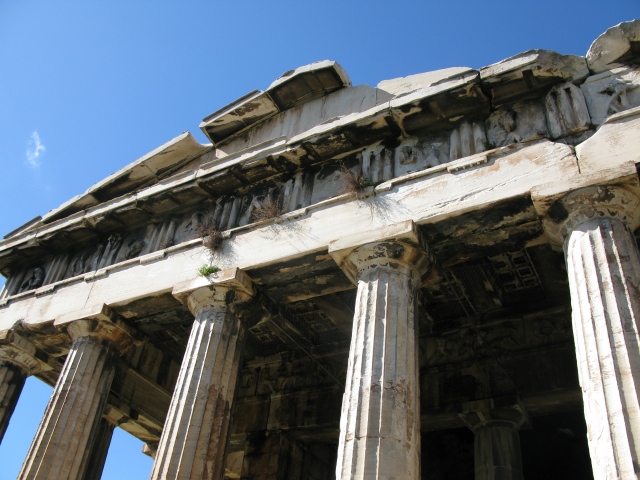

The next ancient site on the agenda has to be the Temple of Olympian Zeus.
This former colossal temple lies in the center of Athens – to the south-east of the Acropolis – and was originally built as part of a number of works designed for Athens by Roman Emperor Hadrian around the year 125 AD.
Situated in, what is now a large green-space in the busy built-up area of Athens, the temple was originally used as a place of worship for the leader of the Olympian Gods and ruler of Mount Olympus.
It is one of two major attractions in this area. The other is Hadrian’s Gate, which sits on the edge of the green space aside a busy multi-lane roadway.
The temple is impressive in its size. Massive columns rise high into the sky and there is the air of the grandeur that would have been present many years’ ago. While you cannot walk among the columns you can go around its perimeter and get an idea of its sheer size and scale.
Entrance to the Temple of Olympian Zeus is free of charge only for children up to five-years-old and EU citizens up to 25-years-old. Everyone else needs to purchase a ticket, which cost €6 (around £5.35).


Slightly further east from the Temple of Olympian Zeus lies the impressive Panathenaic Stadium.
This multi-purpose stadium is the only stadium in the world built entirely of marble; having originally been built in a natural ravine between the two hills of Agra and Ardettos.
It’s history can be dated back all the way to 330 BC when the site housed a simple racecourse.
Originally built with no seating, the development of the stadium was continued over the centuries and – at it’s highest – the capacity of the arena reach 80,000!
In it’s current form, around 40,000 spectators could be squashed into the arena, but the stadium is used more now as a tourist attraction than as a sporting venue.
The stadium itself is a long, traditional-looking, structure with a large oval racecourse running through its center and marble seating accommodating three of the main sides of the arena.
As a visitor to the arena, you arrive in at one end at the bottom level and can walk around the whole track and pose for various photos on the race starting lines or on the winners’ podium.
It’s also worth climbing up to the top the seating area as this gives you a great view of the whole stadium.
Towards one end, there is the old Underground Athletes’ Tunnel which you can venture down, taking you to a small museum exhibition to the history of the Olympic Games.
Tickets can only be purchased at the stadium for €10 (around £8.80) with daily openings starting at 8am.


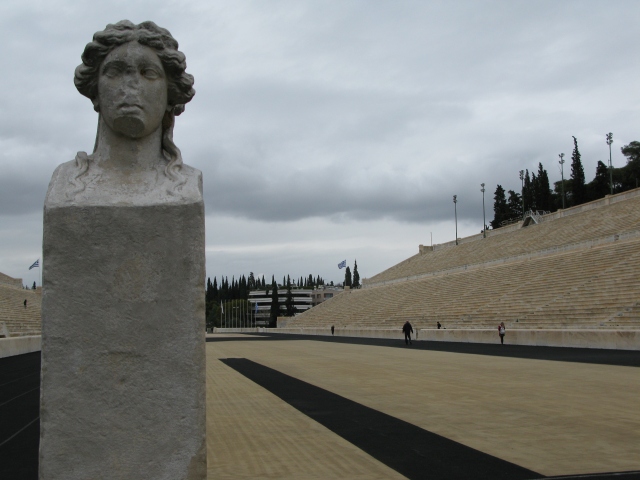

There are a number of great places in Athens to get superb views, but one of the best is afforded from Mount Lycabettus.
Standing at an impressive 277m above sea-level, Mount Lycabettus is the highest point in the whole of Athens.
Situated to the north-east of the Acropolis, Mount Lycabettus is best accessed by traveling on the the M3 metro line to Evangelismos station. From here, a short, pleasant walk will get you to the base of mountain, where you’ll be met with a decision to make; climb up on foot or use the cable car!
For me, the decision was simple. I was always going to take the cable car. For just €10 (around £8.80) you can get a round-ticket or for €7 (around £6.25) you can buy a one-way pass. The cable car operates 365 days a year and starts each day at 9am.
The cable car system – which has run since 1965 – can get busy at peak times and travels between the top and bottom every 20 to 30 minutes, so you may have a short wait to get onto one.
Obviously, if you can, try and get a seat at the front of the cable car. Here you’ll have a large window to view from as you ascend or descend the mountain, giving you great shots of the city as you go.
Once moving, travel time on the cable car is about three minutes each way and when you arrive at the top disembarking is usually quick and efficient.
As mentioned earlier in this blog, there are other locations in the city that give good views of Athens, and some of them are a lot quieter than Mount Lycabettus so do be prepared to have a crowd of people with you at the top.
That being said, this is clearly one of the best spots in the city for a fantastic panoramic view, so it’s well worth the time and money.
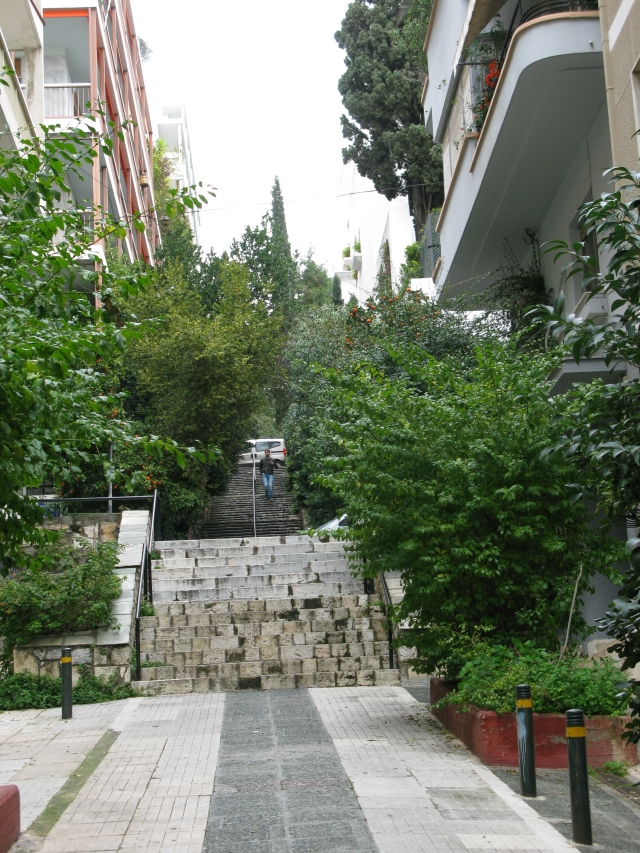

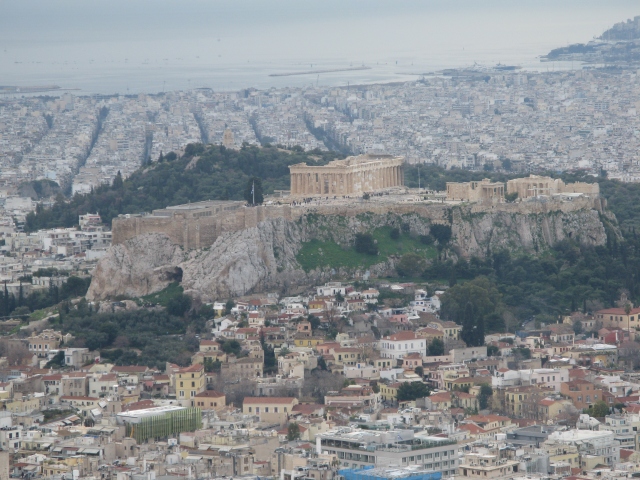
For those who have seen all the ancient sights, there hopefully will be a bit of time to have some fun of a different kind. As an escape room enthusiast, I was keen to try one in Greece and found the superb Athens Clue.
Situated across two locations (with one being outside of central Athens) the best bet is to do a room in the location named Marousi (on a street call Leof. Kifisias) in the north of the city.
Here there are – at the time of writing – five rooms to choose from across a range of themes.
The difference in these rooms to others I’ve tried around the world is that you get 70 minutes to play compared to the usual hour.
When I played, they had a room called World War III, which sadly has been discontinued as it was really good fun (where you pretending to infiltrate North Korea and getting arrested by live-action guards). However, if there current rooms are of the same standard, then the game is sure to be fun to play and satisfactorily challenging also.
Pricing is fairly reasonable. For just €38 for two people (around £33.85) you can pre-book a game and enjoy a lighter-hearted aspect of Greek life.

Where to avoid
Safety-wise, Athens an average crime rate compared to other European countries so the basic rules apply: keep hold of your valuables and be aware of areas that pickpockets may operate in.
Other than that, the city is pretty safe and the people are very friendly and helpful.
Safety-aside, if you are short on time it can be hard to work out which of the city’s many sites and landmarks to skip over.
One ancient site that doesn’t add much to a trip is that of The Prison of Socrates.
This place was named after Socrates because of the belief that the ancient philosopher was imprisoned here. However, all the details about the imprisonment and execution of Socrates were derived from dialogues of Kriton and Phaedo.
Located on the slopes of the Philopappos Hill, immediately to the south-west of the Acropolis, the mysterious set of caves lie.
As you descend the Philoppapos Hill near the Acropolis, you will see a gloomy niche with a rusty metal mesh, which is cut in the rock. This is the Socrates’ prison.
Fortunately, a visit to the ‘prison’ is free, as you will not be able to get inside because of the metal mesh at the entrance meaning any visitors will have to be content with just studying the place from outside.
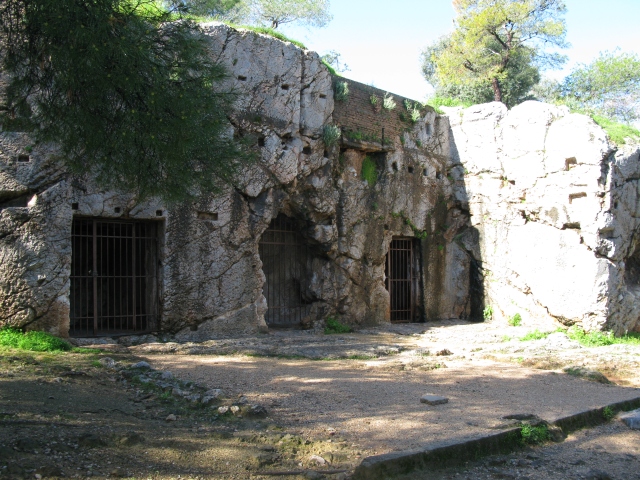
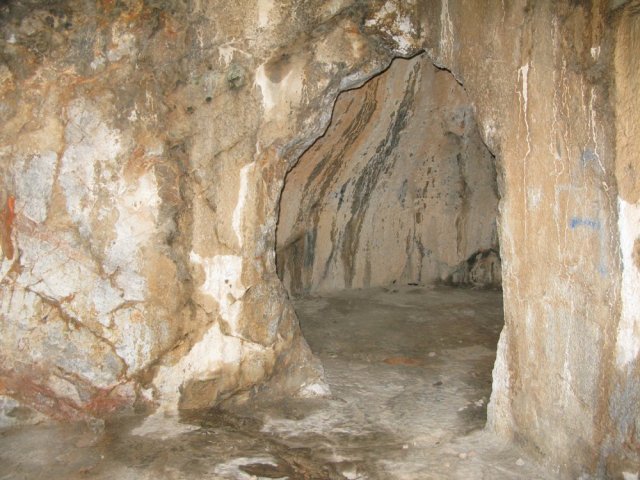
Away from ancient sites, many visitors to Athens go to see the The Presidential Guard in their unique uniforms.
The Presidential Guard is a infantry unit that guard the Tomb of the Unknown Soldier and the Presidential Mansion.
These days the Guards are merely a ceremonial unit, but that doesn’t stop visitors spending time to make the journey to to see them and witness the Changing of the Guards.
However, this really isn’t that thrilling and once you’ve had a good look at the guards in their rather unique – and totally inefficient – uniforms (which include the use of Tsarouchi shoes befit with what looks like a pompom on the front – there is very little else to do here.
Don’t waste your time with this and spend your time in Athens searching for more fun and interesting things to see and do.


Great places to eat
Athens – and indeed Greece in general – is home to some of the world’s best cuisine. During my stay in the city I enjoyed a variety of great food and drink so I’m going to try and explain my best bets for a lunch time and evening meal.
But the first thing to mention is that no matter what meal you’re enjoying, make room to sip on a couple of bottles of Mythos beer.
Personally, I love trying local brews when I travel, so was keen to sample this one as well. And while beer may not be to everyone’s taste, this light beer is an enjoyable drink to savour while planning the next part of your Greek adventure.
Upon arrival in Athens – and after checking into my AirBnB – I made my way out and stopped at a small restaurant near the Acropolis for a light snack.
Here was my first opportunity to sample a bottle of Mythos and it didn’t disappoint (although I did manage to sit right next to a sign advertising the local Alcoholics Anonymous group meeting which did make me feel slightly self-conscious about my drink of choice)!

Away from alcohol, there are plenty of options in Athens to grab a light, affordable lunch. One place I particularly enjoyed was iFeel.
This trendy eatery is located a short distance north of the Acropolis of Athens on a small backstreet called Karaiskaki 33.
The entrance to the establishment is welcoming and you’ll find different menu options designed to suit your moods.
Tasty picks such as their signature Black Angus burger, fresh salads that are perfect for a late snack, or a wide brunch selection, are a few of the options available.
For around €10 (around £8.90) you can get a lunch option such as a club sandwich and for a few extra Euros you can add on a hot or cold drink also.
The relaxed nature of the iFeel means that while food is a quick affair, you don’t feel rushed and you can sit back and enjoy your breakfast or lunch without being hurried out the door.

My final pick is an expensive one, but as a location for a special evening meal, this is right up there with the best I’ve ever experienced.
The upmarket restaurant Aleria is located on Meg. Alexandrou 57; a 35 minute walk north-west from the Acropolis of Athens.
Getting to the restaurant is fairly easy. There are three main suggestions. The first being to walk it (although after a big meal this may not be advisable). The second suggestion is to order a taxi (the restaurant will do this for you, for your return journey home after your meal) or the third option (and the one I took) is to use the metro (the closest station is Metaxourgeio on Line 2 of the Athens Metro).
Once you’re inside the restaurant you’ll be welcomed in by the extremely attentive staff and the delightfully decorated interior.
This charming restaurant inspired by Greek gastronomical tradition and has two tasting menus to choose from (the Earth & Sea menu or the Garden & Nature menu); with options on both to have either five or six courses along with wine pairings.
I wanted to make this a special meal, so opted for the six course Earth & Sea menu alongside the wine pairings.
The food was exquisite. There were wonderful seafood dishes that included crab and fresh fish, while meat courses ranged from lamb to beef. Beautifully presented, the meal was then perfectly accompanied by the appropriate wines.
Now, usually, I’m not one for the wine pairings. Two main reasons being that they are, more often-than-not, hugely overpriced and surrounded by a great deal more pomp and ceremony than I’m comfortable with. Neither of these issues were the case here and, in fact, the sommelier was friendly and informative without their being any pomposity to his explanations of what I was getting.
The meal lasted for around three hours and there are a number of small breaks between courses that allow you to savour what you’ve just been eating.
As mentioned, this is not a restaurant experience you’ll be able to do very cheaply, but the expense is worthwhile given the food and the service you get.
For my six courses I paid €78 per person (around £69) with an additional €48 per person for the wine pairing (around £42.50); making the bill (before tip) €126 per person (around £111.50) in total.
Don’t get me wrong, this is a lot of money for a single dinner. However, if you are looking for somewhere special to go for the evening that offers great local dishes and first-class service, then you won’t go far wrong by enjoying a night out, during your Athens adventure, at Aleria.

Useful links
Acropolis of Athens & Parthenon
Remember you can follow World Complete on Twitter, Instagram, Pintrest, Tumblr and Facebook send your comments and pictures from your travels using #WorldComplete and #Travel.


Thanks for sharing, I have not been to Athens before, so this guide is very helpful to know what to see, stay and eat 🙂
LikeLiked by 1 person
Hi Nic! Thanks so much for stopping by World-Complete.com. I’m glad you enjoyed my blog. Best wishes
LikeLike
I adore Athens – I visited there on a college trip and went to most of the places you have mentioned. I also enjoyed the market area in the town, and the Acropolis Museum was such a great place to sit and sketch! I imagine it’s changed a bit from when I was there but I would love to go back.
LikeLiked by 1 person
Hi Hannah. Athens is a great city, you’re so right. I bet it’s not changed as much as you may think though. Hopefully you’ll get back there again soon. Thanks for stopping by 🙂
LikeLike
Such a wonderful article!
Thanks a lot for sharing it
LikeLiked by 1 person
Thank you for the kind comments and for once stopping by my blog 🙂
LikeLiked by 1 person
You’re more than welcome!
LikeLiked by 1 person
Wow, really interesting and detailed. Thank you. Greece is a place I hold dear to my heart and am ashamed to admit I’ve never been to Athens. Been to Olympia, and islands though. This is now on the list.
LikeLiked by 1 person
Thanks so much for the kind comment and stopping by to read the blog. Hope you found it helpful.
LikeLike